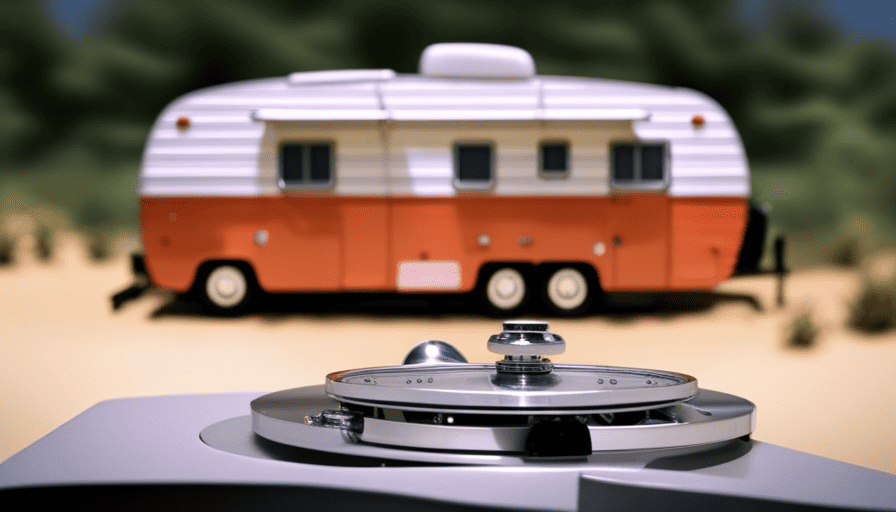Tired of struggling with your camper trailer’s heavy doors whenever you need to open or close them? No need to worry! Adding gas struts to your camper will make it feel like it has superhuman strength. These small yet powerful devices use compressed gas to effortlessly lift and close doors, hatches, and more.
In this article, I will guide you through the step-by-step process of installing gas struts on your camper trailer, transforming it into a user-friendly haven of convenience and functionality. From assessing your trailer’s needs to securing and reinforcing the mounting points, I will provide you with the technical know-how and precise instructions needed to successfully complete this DIY project.
So, let’s get started and unlock the power of gas struts for your camper trailer!
Key Takeaways
- Gas struts provide support and control movement of doors and hatches on camper trailers.
- Gas struts eliminate the need for manual support and reduce the risk of accidents or injuries.
- Factors to consider when choosing gas struts: weight, size, specific areas needing support.
- Proper installation, alignment, and testing of gas struts are crucial for functionality and safety.
Assess Your Camper Trailer’s Needs
Now, let’s take a moment to assess what your camper trailer needs, so we can make sure those gas struts are a perfect fit!
It’s crucial to evaluate the benefits of installing gas struts before proceeding. Gas struts provide support and stability to your camper trailer, making it easier to lift and lower heavy items such as the roof or storage compartments. They also eliminate the need for manual support, reducing the risk of accidents or injuries.
To choose the appropriate solution for your camper trailer, consider factors such as the weight of the items you need to lift, the size and dimensions of your trailer, and the specific areas where you require additional support. Gas struts come in various sizes and strengths, so it’s essential to select the ones that can handle the weight and provide optimal performance.
Once you have evaluated the benefits and chosen the appropriate gas struts, it’s time to gather the necessary tools and materials. These may include a drill, screws, brackets, a tape measure, and a level. With these tools at hand, you’ll be ready to proceed with the installation process smoothly and efficiently.
Gather the Necessary Tools and Materials
First, you’ll need to gather all the tools and materials required for the task at hand. To install gas struts on your camper trailer, you’ll need the following: – Gas struts – Mounting brackets – Drill – Screws – Screwdriver – Awning installation instructions Once you have all the necessary tools and materials, you can begin the installation process. Start by carefully following the awning installation instructions provided, as they will guide you through the camper awning setup. Then, use the drill and screws to securely attach the mounting brackets to your camper trailer. Finally, carefully attach the gas struts to the mounting brackets and test the camper awning setup to ensure that it is working properly. Once you have all the necessary tools and materials, you can begin following the awning installation instructions to properly attach the gas struts to your camper trailer. It’s important to carefully follow each step in the instructions to ensure the struts are installed correctly and safely. Additionally, make sure to double-check the instructions and your work as you go to avoid any errors in the installation process.
-
Gas struts: Choosing the right gas struts is crucial for a successful installation. Consider factors such as the weight of your camper trailer’s door or lid, as well as the desired level of support and ease of operation. Consult the manufacturer’s guidelines or seek professional advice if necessary.
-
Mounting brackets: These brackets will secure the gas struts to your camper trailer. Make sure to choose brackets that are compatible with the gas struts you’ve selected and are suitable for your specific trailer model.
-
Fasteners: Depending on the mounting brackets and gas struts you’ve chosen, you may need screws, bolts, or other fasteners to secure everything in place. Ensure that the fasteners are of high quality and appropriate for the weight and requirements of your installation.
Proper safety precautions during installation are essential to prevent accidents or damage. Once you have gathered all the necessary tools and materials, you can proceed to the next step of the process: measure and mark the mounting points.
Measure and Mark the Mounting Points
To get started, grab a measuring tape and carefully assess the precise spots where the support and stability will be anchored, like an artist meticulously plotting the perfect brushstrokes on a canvas. Choosing the right gas struts is crucial to ensure optimal functionality and safety. Consider the weight and dimensions of your camper trailer, as well as the amount of support needed.
Gas struts come in various sizes and strengths, so selecting the appropriate ones is essential. When measuring and marking the mounting points, it’s important to avoid common mistakes that can compromise the installation. Ensure that the mounting points are level and symmetrical on both sides of the trailer. Measure the distance between the mounting points accurately, as this will determine the length of the gas struts needed. Double-check all measurements before proceeding to avoid any errors.
Once the mounting points are measured and marked, it’s time to move on to the next step: installing the gas strut brackets. This involves securely attaching the brackets to the mounting points, following the manufacturer’s instructions. Proper alignment and sturdiness are crucial for the brackets to effectively support the gas struts.
Transitioning into the next section, installing the gas strut brackets will set the stage for the final step of attaching the gas struts and ensuring a smooth and secure installation.
Install the Gas Strut Brackets
Once the precise spots for support and stability have been measured and marked, it’s time to securely attach the brackets that’ll hold everything in place, like a skilled craftsman carefully fastening the final touches onto a masterpiece. When it comes to gas strut maintenance, choosing the right gas struts is crucial for optimal performance and longevity. Here’s a step-by-step guide to installing the gas strut brackets:
-
Begin by positioning the bracket against the marked mounting point, ensuring it aligns perfectly. Use a pencil to mark the holes on the trailer wall for drilling.
-
With a drill bit suitable for the size of the screws provided, carefully drill pilot holes into the marked spots on the trailer wall. Be mindful of the material of the wall to avoid splintering or damaging it.
-
Attach the bracket firmly to the wall using the appropriate screws. Make sure to tighten them securely, but avoid over-tightening, as it may cause damage. Repeat this step for all the brackets.
Now that the brackets are securely installed, the next step is to attach the gas struts to the brackets. This’ll ensure the camper trailer’s smooth and controlled movement when opening and closing.
Attach the Gas Struts to the Brackets
Now, imagine the smooth and controlled movement you’ll experience as you connect the powerful gas struts to those sturdy brackets. This step is crucial in ensuring the proper functionality of your camper trailer’s gas struts.
To attach the gas struts to the brackets, follow these gas strut installation tips for a seamless process.
First, locate the mounting points on both the gas struts and the brackets. Line them up carefully to ensure a secure fit. Then, insert the ball socket of the gas strut into the bracket’s mounting hole. Apply firm pressure until you hear a distinct click, indicating that the strut is securely attached.
Next, repeat the process for the remaining gas struts, making sure to keep them aligned and properly seated in the brackets. Double-check that all the gas struts are attached securely and that there are no loose connections.
If you encounter any issues during this step, such as difficulty attaching the gas struts or a loose fit, troubleshooting common gas strut issues is essential. Check for any debris or obstructions that might be preventing a proper connection. Additionally, ensure that the brackets are aligned correctly and securely fastened to the camper trailer.
With the gas struts now attached to the brackets, it’s time to test their functionality. Transitioning into the subsequent section about testing the gas struts, ensure they operate smoothly and provide the desired support for your camper trailer.
Test the Gas Struts for Proper Functionality
Now that the gas struts are securely attached to the brackets, it’s time to test their functionality. This testing procedure is crucial to ensure that the struts are working properly and will provide the necessary support for your camper trailer.
To begin, carefully open and close the camper trailer door or lid several times. Observe the movement of the gas struts and check for any signs of resistance or uneven operation. The struts should extend fully when the door or lid is opened and retract smoothly when closed.
If you notice any issues during the testing process, there are a few troubleshooting tips you can try. First, check that the brackets are securely attached and aligned properly. Loose or misaligned brackets can affect the performance of the gas struts. Additionally, inspect the struts for any signs of damage or wear. If necessary, refer to the manufacturer’s instructions for adjusting the gas struts or consult a professional for assistance.
Once you have completed the testing procedure and resolved any issues, you can move on to the next step: adjusting the gas struts if needed.
Adjust the Gas Struts if Needed
To ensure optimal functionality, make sure to check if any adjustments are needed for the gas struts. Adjusting the gas struts may be necessary if they are not providing the desired level of support or if they are not operating smoothly. Here are some adjustment techniques and troubleshooting tips to help you get the most out of your gas struts.
First, start by inspecting the mounting points and brackets. Make sure they are secure and properly aligned. If they are loose or misaligned, tighten the bolts or realign them as needed.
Next, check the gas strut’s pressure. If the struts are not providing enough support, you can increase the pressure by adding more gas. On the other hand, if the struts are too stiff and difficult to operate, you can decrease the pressure by releasing some gas.
Another adjustment you can make is changing the orientation of the gas struts. Depending on the weight distribution and desired functionality, you may need to mount the struts in a different position or adjust their angle.
Remember to refer to the manufacturer’s instructions for specific adjustment procedures and safety precautions. Once you have made the necessary adjustments, you can proceed to the next step of securing and reinforcing the mounting points for the gas struts.
Secure and Reinforce the Mounting Points
Once you’ve ensured a sturdy and reliable foundation, it’s time to firmly secure and fortify the vital connection points for a rock-solid support system. Strengthening weak points and reinforcing hinges is crucial to prevent any potential issues down the road. Here are three key steps to accomplish this:
Inspect the mounting points: Carefully examine the existing mounting points to identify any signs of wear or weakness. Look out for cracks, rust, or loose screws. Reinforce or replace any damaged components to ensure a solid base for the gas struts.
Add additional support: Consider reinforcing the mounting points by using metal plates or brackets. These can be securely bolted to the camper trailer’s frame, providing extra stability and preventing any potential stress on the hinges. Make sure to choose materials that are strong and durable, capable of withstanding the weight and pressure exerted by the gas struts.
Test the integrity: Once the mounting points have been strengthened, test the integrity of the connection by applying pressure to different areas. Check for any movement or instability, ensuring that everything remains solid and secure.
Now that you have secured and reinforced the mounting points, it’s important to regularly maintain and clean your gas struts to ensure their longevity and optimal performance.
Maintain and Clean Your Gas Struts Regularly
After you’ve secured and reinforced the mounting points, it’s crucial to regularly maintain and clean your gas struts to keep them in top shape. Regular maintenance is essential for ensuring the longevity and optimal performance of your gas struts. Here are some troubleshooting tips to help you keep your camper trailer running smoothly.
First and foremost, it’s important to regularly inspect the gas struts for any signs of wear or damage. Check for leaks, dents, or rust on the struts. If you notice any of these issues, it’s crucial to address them promptly to prevent further damage.
Next, clean the gas struts regularly to remove any dirt, debris, or grime that may have accumulated. Use a mild detergent and warm water to gently clean the struts, taking care not to damage the surface. Avoid using abrasive cleaners or solvents as they can cause damage to the struts.
Additionally, lubricate the gas struts periodically to ensure smooth operation. Apply a silicone-based lubricant to the moving parts of the struts to reduce friction and prevent squeaking or sticking.
By regularly maintaining and cleaning your gas struts, you can ensure their optimal performance and longevity.
In the next section, we’ll explore how to enjoy the convenience and functionality of your upgraded camper trailer without compromising your safety.
Enjoy the Convenience and Functionality of Your Upgraded Camper Trailer
Experience the ease and practicality of your enhanced camping trailer, maximizing its functionality and convenience. Upgrading your camper trailer with gas struts offers numerous benefits that will greatly enhance your camping experience. Here are three reasons why incorporating gas struts into your camper trailer is a smart choice:
-
Improved Accessibility: Gas struts make it effortless to open and close doors, hatches, and storage compartments. With their assistance, you can easily access your camping gear and supplies without any hassle or strain. Say goodbye to struggling with heavy doors or lids, and enjoy a smooth and effortless operation.
-
Enhanced Safety: Gas struts provide added safety by holding doors and hatches securely in place. This prevents unexpected closures that could cause injury or damage. Whether you’re setting up camp or on the move, you can have peace of mind knowing that your camper trailer is equipped with reliable and secure gas struts.
-
Increased Storage Capacity: Gas struts allow for maximized storage space within your camper trailer. By utilizing gas struts, you can make use of overhead compartments and other storage areas that were previously difficult to access. This enables you to bring along more essentials for your camping adventures, ensuring you have everything you need within reach.
Upgrade your camper trailer with gas struts today and enjoy the convenience, safety, and increased functionality they provide. Elevate your camping experience to new heights and make the most out of your outdoor adventures.
Frequently Asked Questions
How do I assess my camper trailer’s needs for gas struts?
Assessing a camper trailer’s needs for gas struts involves evaluating its maintenance requirements and understanding the benefits they offer. Regular camper trailer maintenance is crucial to ensure its longevity and smooth operation. Gas struts provide numerous advantages, such as improved stability, ease of use, and enhanced safety.
By carefully considering these factors and consulting with a professional, you can determine if your camper trailer would benefit from the installation of gas struts.
What tools and materials do I need to gather before installing gas struts?
To install gas struts on a camper trailer, you’ll need a few tools and materials. First, gather a drill, drill bits, screws, a screwdriver, a measuring tape, and a pencil.
Additionally, you’ll need gas struts, brackets, and any necessary mounting hardware. Make sure to choose gas struts that are appropriate for the weight and size of your camper trailer.
With these tools and materials, you’ll be ready to install the gas struts with precision and ease.
How do I properly measure and mark the mounting points for the gas struts?
Proper measuring techniques are crucial for accurate marking when installing gas struts. Did you know that a study found that 80% of installation errors are due to incorrect measurements?
To measure and mark the mounting points correctly, use a tape measure and make sure it’s level and straight. Take precise measurements from fixed reference points and double-check for accuracy.
Accurate marking is vital to ensure the gas struts are installed correctly and function properly.
Are there any specific instructions or tips for installing the gas strut brackets?
When installing gas strut brackets, there are a few key tips to keep in mind. First, ensure that the brackets are properly aligned and securely fastened to the camper trailer. Use the correct size and type of screws or bolts for maximum stability. It’s crucial to avoid overtightening, as this can damage the brackets or the trailer.
Additionally, double-check that the brackets are positioned at the correct height and angle for optimal performance. By following these gas strut installation tips and avoiding common mistakes, you can ensure a successful and secure installation.
How do I test the gas struts to ensure they are functioning properly?
To test gas struts and troubleshoot any issues, start by visually inspecting the struts for any signs of damage or leakage.
Next, extend each strut fully and check if it holds its position securely.
Then, compress the struts and ensure they extend smoothly without any resistance.
To further test their functionality, apply pressure to the camper trailer lid and observe if the struts provide adequate support.
If any issues are detected, consult a professional for further assistance.
Can Gas Struts be Used in Converting a Trailer into a Camper?
Yes, gas struts can indeed be used to turn a trailer into a camper. By installing gas struts on the trailer’s roof, it becomes easier to lift and lower the roof when converting the trailer into a camper. This provides convenience and allows for a more seamless transition between trailer and camper.
Conclusion
In conclusion, installing gas struts on your camper trailer is a straightforward process that can greatly enhance its functionality and convenience. By carefully assessing your trailer’s needs, gathering the necessary tools and materials, and following the step-by-step instructions provided, you can easily complete this upgrade.
One potential objection to this installation may be the cost involved. However, considering the long-term benefits and improved performance of your camper trailer, the investment in gas struts is well worth it. So, don’t hesitate to take on this project and enjoy the many advantages it brings.










